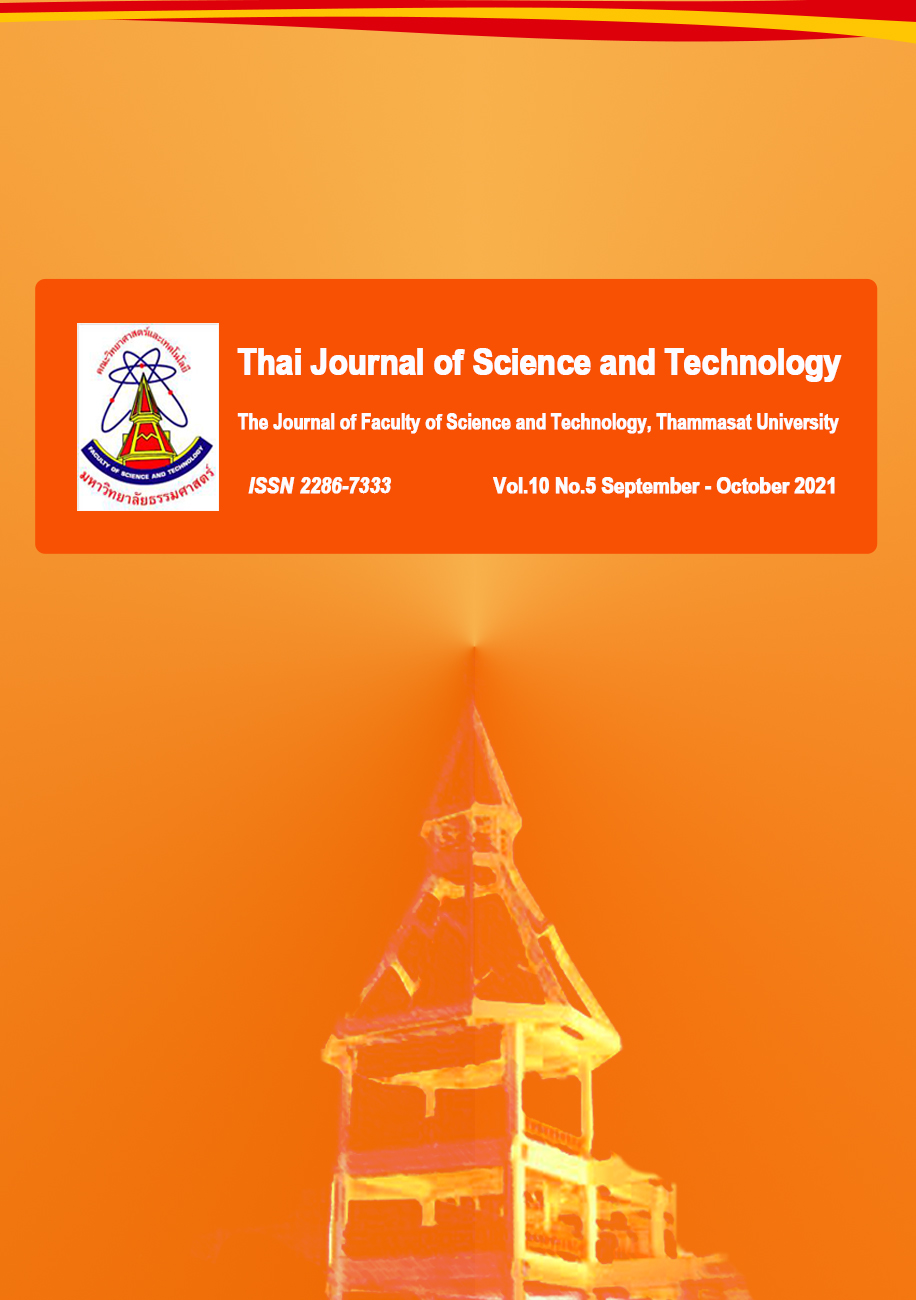Efficacy of Cellulose Film Mixed with Microencapsulation of Essential Oils Inhibited Lasiodiplodia theobromae Causing Fruit Rot of Longkong
Main Article Content
Abstract
The efficacy of essential oil microcapsules in inhibiting the pathogenesis of rot fruit in longkong caused by L. theobromae testing with the Paper disc method, arrangement by a completely randomized trial (CRD). The result was found that at 24 hours, 10% of essential oil microcapsules from dill seeds with GA encapsulation has the most antifungal efficacy with the diameter colony were 2.30±1.75 cm, followed by 10% anise and 5% dill essential oil microcapsules with GA encapsulation with colonies of 3.91±0.18 and 4.03±0.03 cm, respectively, were not statistically different (P<0.05). After incubated at 48-hour found that the 5%dill essential oil with GA encapsulation remained the most effective inhibitor of fungal growth with colony were 3.66±0.22 cm. The efficacy of film cellulose mixed with microcapsules of essential oil testing with spray coating and stored at room temperature. The longkong coated with film cellulose mixed with 10% of essential oil microcapsules from dill seeds with GA encapsulation had the longest storage life to 5 days while the control can be storage life for 3 days.
Article Details

This work is licensed under a Creative Commons Attribution-NonCommercial-NoDerivatives 4.0 International License.
บทความที่ได้รับการตีพิมพ์เป็นลิขสิทธิ์ของคณะวิทยาศาสตร์และเทคโนโลยี มหาวิทยาลัยธรรมศาสตร์ ข้อความที่ปรากฏในแต่ละเรื่องของวารสารเล่มนี้เป็นเพียงความเห็นส่วนตัวของผู้เขียน ไม่มีความเกี่ยวข้องกับคณะวิทยาศาสตร์และเทคโนโลยี หรือคณาจารย์ท่านอื่นในมหาวิทยาลัยธรรมศาสตร์ ผู้เขียนต้องยืนยันว่าความรับผิดชอบต่อทุกข้อความที่นำเสนอไว้ในบทความของตน หากมีข้อผิดพลาดหรือความไม่ถูกต้องใด ๆ
References
Dejsuk, N., Vongsawasdi, P., Nopharatana, M., Phadthong, C., & Punyamoonwongsa, T. (2011). Effect of jasmine-essential oil encapsulated in modified starch on the survival of Staphylococcus aureus inoculated in Lookchup. In The 49th Kasetsart University Annual Conference: Agro-Industry (pp. 484-456). (in Thai)
Inthajak, N., Sirichote, A., Suanphairoch, S., & Puengphian, C. (2011). Changes of quality and respiration rate of Longkong (Lansium domesticum Corr.) fruits after harvest and at the senescent stage. Agricultural Science Journal, 42(1), 87-90. https://agris.fao.org/agris-search/search.do?recordID=TH2021000339 (in Thai)
Kamazeri, T. S. A. T., Samah, O. A., Taher, M., Susanti, D., & Qaralleh, H. (2012). Antimicrobial activity and essential oils of Curcuma aeruginosa, Curcuma mangga, and Zingiber cassumunar form Malaysia. Asian Pacific Journal of Tropical Medicine, 5(3), 202-209. DOI: 10.1016/S1995-7645(12)60025-X
Pakthongchai, J., & Chuaboon, W. (2020a). Development of essential oil micro-capsule for preserving shelf-life of agricultural products. In The 3rd National Conference on Science: Technology and Innovation (pp. 257-263). Rajamangala University of Technology Phra Nakhon. (in Thai)
Pakthongchai, J., Athinuwat, D., & Chuaboon, W. (2020b). Efficiency of essential oils on inhibition of pathogenic fungus causing fruit rot of Longkong after harvesting. In The 7th King Mongkut’s Agriculture Conference (KMAC2020) (pp. 25-30). King Mongkut's Institute of Technology Ladkrabang. (in Thai)
Pianpumepong, P., Rarai, N., & Meeklangsaen, W. (2014). Application of edible chitosan film for post-harvest shelf life of Annona squamosal Linn. Petch pakchong variety. RMUTI Journal Science and Technology, 8(3), 19-31. https://ph01.tci-thaijo.org/index.php/rmutijo/article/view/44893 (in Thai)
Pithakpol, W., Peerae, W., Pojanataree, P., & Vorapunthu, S. (2016). Effect of carboxymethyl cellulose from water hyacinth on postharvest quality of Longkong. Khon Kaen Agricultural Journal, 44 (Suppl 1), 879-886. ag2.kku.ac.th/kaj/PDF.cfm?filename=P083%20Hor372.pdf&id=2463&keeptrack=2 (in Thai)
Pithakpol, W., Soisom, S., & Nimitkeatkai, H. (2014). Effect of methyl jasmonate fumigation and chitosan coating on postharvest quality of Longkong fruits. Khon Kaen Agricultural Journal, 42(Suppl 1), 589-595. https://ag2.kku.ac.th/kaj/PDF.cfm?filename=P551.pdf&id=1354&keeptrack=6 (in Thai)
Ponghirantanachoke, N. (2017). Developing a packaging prototype with binding plant extract for exporting organic Cavendish banana. (Master Degree), Thammasat University, Faculty of Science and Technology, Department of Agricultural Technology. (in Thai)
Postharvest and Processing Research and Development Division. (2014). Post-harvest diseases of fruits. Chamchuree Products CO., LTD., Bangkok. 129 p. (in Thai)
Sittipummongkol, K., & Pechyen, C. (2018). Production, characterization and controlled release studies of biodegradable polymer microcapsules incorporating neem seed oil by spray drying. Food Packaging and Shelf Life, 18, 131-139. DOI: 10.1016/J.FPSL.2018.09.001
Suwijak, S., Athinuwat, D., & Chuaboon, W. (2019). Development of cellulose thin film mixed with beneficial bacteria to prolong shelf life of sweet pepper. Science Journal Chandrakasem Faculty of Science Chandrakasem Rajabhat University, 29(3), 56-61. file:///C:/Users/User/Downloads/5-Article%20Text-17-1-10-20210723.pdf (in Thai)
Wachiracharoenwong, K., & Kampeerapappun, P. (2015). Antibacterial and tick repellent properties of microcapsules containing plai oil. UTK research journal, 9(2), 1-6. http://dspace.rmutk.ac.th/handle/123456789/153 (in Thai)


